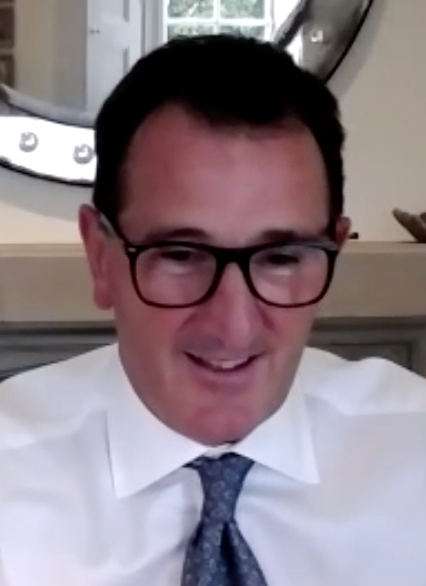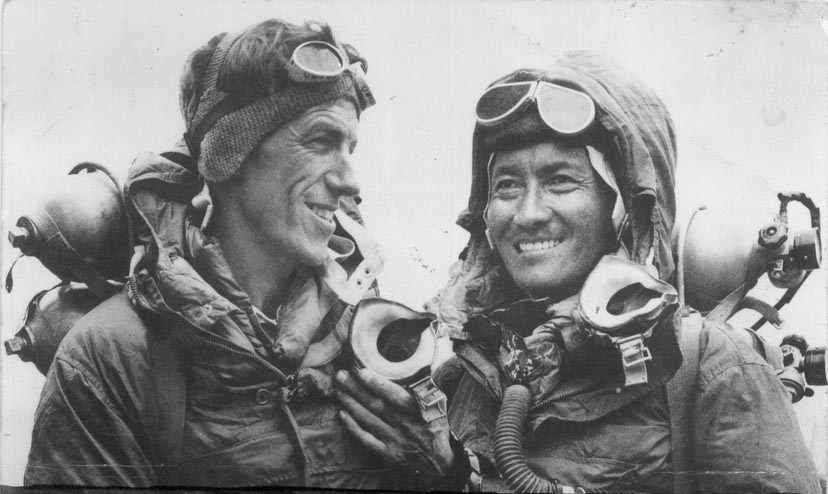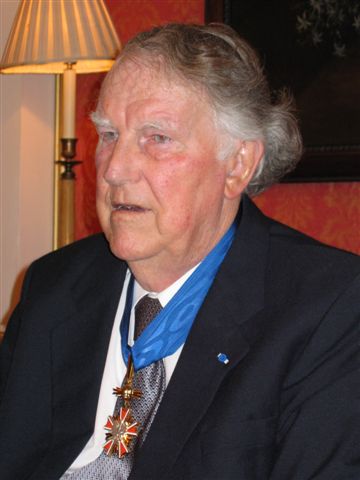 Abraham Lincoln
If given the truth, the people can be depended upon to meet any national crisis...
Abraham Lincoln
If given the truth, the people can be depended upon to meet any national crisis...
 Guildford news...
for Guildford people, brought to you by Guildford reporters - Guildford's own news service
Guildford news...
for Guildford people, brought to you by Guildford reporters - Guildford's own news service
Dragon Interview: Sir Graham Wrigley – Everest Experience Inspired Third World Journey Leading to Honour
Published on: 16 Oct, 2020
Updated on: 18 Oct, 2020
Guildford has a new knight, Sir Graham Wrigley, who lives in Chilworth.
Sir Graham is a Knight Companion of the Order of St Michael and St George, an honour for those who render important non-military service in a foreign country, in Sir Graham’s case, for services to overseas development.
In his interview with Martin Giles, Sir Graham is insistent the award is really due to the work of many. But given the local connection (and after a bit of arm-twisting), he was persuaded to share some of his story.
I believe your interest in this area of service stems from a visit to India and Nepal when you were just 19. Tell us about that.
In a gap year, I travelled around India and Nepal and I was up in the Everest region. This was 1981 so it was very undeveloped then, and I was sitting on a wall outside a school above Namche Bazar chatting to this older guy who asked me how high I’d been and I told him proudly that I’d been over 6,000 metres and he said: “That’s really great.”
Then a little later the Sherpa I was with said: “So what do you think of Sir Edmund?” I could hardly believe this quiet man was Sir Edmund Hillary who had conquered Everest with Tenzing Norgay. I felt so embarrassed I had been boasting to him how good my exploits were. The school we were sitting by was actually one he had built for the Sherpas after he created the Himalayan Trust. He has always inspired me.
So, this, and the time I spent in India seeing people living in such poverty made me think that if I had a chance later in life I would do something to give back.
Do you think exposure to the Third World is an important part of education?
I think it is. Exposure to other cultures and seeing other countries is great. When I do talks at schools I always tell people: “Have a gap year. Do things.” Schools don’t always want them to do that but for me it was life-changing, it definitely was. I learnt so much about myself and about other people. Obviously, there are issues now with Covid and climate change, but I think it so important to understand other parts of the world.
Did things develop from your meeting with Sir Edmund Hillary?
As I mentioned, Sir Ed had set up the Himalayan Trust, which was built on great principles. For example, he wanted to do things only the Sherpas really needed, and would be prepared to contribute to themselves.
He would say: “OK, you want a school. I will buy the cement and the corrugated iron for the roof, the community should collect the stones and we will build the school together.”
After I finished university at Cambridge and I moved to work in London I started raising money for the Himalayan Trust. For example, I did a series of fundraisers called “The Yeti Balls”. These raised quite a lot of money at the time, and I would send the cheques to Ed and we got to know each other.
He then suggested that I should meet his great friend and fellow Kiwi who was coming to live in the UK, George Lowe. George had also been also on the successful 1953 Everest Expedition. So that’s how we set up the Himalayan Trust UK.
And we try to follow the principles Sir Ed created in the work we do today. When the terrible earthquakes happened in Nepal in 2015 we ended up rebuilding 160 classrooms. We always asked for community contributions so we know they will value it, that they have a stake in the outcome and will look after it. It also means that our donor money can make a bigger difference.
In parallel to your early charity work, you went into the private sector. What did you do there?
I started at Bain, a management consultancy, then I did an MBA at INSEAD Business School in France. And then I was one of the founders of a firm called Permira, a big private equity firm and I worked there for 18 years.
I was one of the guys managing the firm but I still had that commitment I had made to myself from back when I was 19 that if I got fortunate enough I would do a second career in international development. So, in 2005, when I was 43, I surprised my colleagues by saying I was going to step down from Permira and re-train for a new career.
I went back to university at SOAS and did a masters in Development Economics, and then started to visit places such as Sierra Leone and Nepal to see where I could contribute.
I had no medical or teaching skills so thought I would be most useful if I used the experience I had acquired in investing by trying to bring long-term, patient capital to poorer countries so they could grow and create jobs, pay taxes to pay for public services, and so on.
And you worked in India?
Yes, I have worked in India in micro-finance since 2007 but also worked in SME investing in Africa, microfinance in Nepal, and in development finance in general across Africa and South Asia. I have been lucky enough to work in many amazing countries, Congo, Pakistan, Sierra Leone and many others.
Then in 2013 you became chairman of CDC.
Yes, CDC is the UK development finance institution, the private sector arm of what is now the Foreign, Commonwealth and Development Office. CDC, which used to be called the Commonwealth Development Corporation, was set up in 1948. Our second chairman, Lord Reith of BBC fame, described CDC’s mission as doing good without losing money
Our role is to support the growth of the private sector in the poorest countries of the world by providing long-term capital in the form of investment to create jobs and help their economies grow. We don’t give grants, we make investments, and these are recycled into new projects, but our balance sheet remains 100% owned by the UK taxpayer. Increasingly, we are doing a lot of work on climate change.
And it is that activity for which you have been honoured?
The citation defined broadly for work international development, covering CDC, the Himalayan Trust, Cashpor, Samriddha Pahad, and other work. Of course, I feel very fortunate to have worked with these great organizations with so many amazing people, and I really believe this honour is shared by them. And, of course, Mia, my wife, who has supported me throughout my career.
You live in Chilworth Manor, previously occupied by another knight, Sir Lionel Heald who served as the attorney general during Churchill’s government in the 1950s, and his wife Lady Heald and you have charitable functions there to don’t you?
Yes. Though we never met her, we have been inspired by Lady Heald who did so much for local charities and the National Garden Scheme when she lived here. We have a whole series of events, about one a month, on average, through the year.
“Picnics and Pimm’s” is the one we are most well-known for. They are a series of outdoor concerts that supports local charities and we have been running that for 10 years now. Lady Heald was a pioneer in the NGS so the annual NGS Open Day is close to our hearts too.
So is your family getting used to calling you Sir Graham?
Definitely not. My wife is Swedish and my kids call me Pappa and once a Pappa always a Pappa.
See also: OBE Honour for Conservative Councillor Julie Iles For Helping Women Make Their Mark
Recent Articles
- Guildford Institute’s Crowdfunding Project for Accessible Toilet in its New Community and Wellbeing Centre
- Letter: Guildford – Another Opportunity Missed?
- Letter: GBC’s Corporate Strategy – Where Is the Ambition?
- My Memories of John Mayall at a Ground-breaking Gig in Guildford Nearly Six Decades Ago
- Westborough HMO Plans ‘Losing the Heart of the Street’ Says Resident
- College Invests to Boost Surrey’s Economy and Close Digital Skills Gap
- Community Lottery Brings Big Wins for Local Charities
- GBC Housing Plan Promises ‘A Vibrant Urban Neighbourhood’ Near Town Centre
- Hospital Pillows ‘Shortage’ at the Royal Surrey
- Updated: Caravans Set Up Camp at Ash Manor School


Search in Site
Media Gallery
Dragon Interview: Local Artist Leaves Her Mark At One of England’s Most Historic Buildings
January 21, 2023 / No Comment / Read MoreDragon Interview: Lib Dem Planning Chair: ‘Current Policy Doesn’t Work for Local People’
January 19, 2023 / No Comment / Read MoreA3 Tunnel in Guildford ‘Necessary’ for New Homes, Says Guildford’s MP
January 10, 2023 / No Comment / Read More‘Madness’ for London Road Scheme to Go Ahead Against ‘Huge Opposition’, Says SCC Leader
January 6, 2023 / No Comment / Read MoreCouncillor’s Son Starts Campaign for More Consultation on North Street Plan
December 30, 2022 / No Comment / Read MoreCounty Council Climbs Down Over London Road Works – Further ‘Engagement’ Period Announced
December 14, 2022 / No Comment / Read MoreDragon Interview: GBC Reaction to the Government’s Expected Decision to Relax Housing Targets
December 7, 2022 / No Comment / Read MoreHow Can Our Town Centre Businesses Recover? Watch the Shop Front Debate
May 18, 2020 / No Comment / Read More












Recent Comments